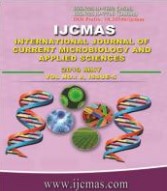


 National Academy of Agricultural Sciences (NAAS)
National Academy of Agricultural Sciences (NAAS)

|
PRINT ISSN : 2319-7692
Online ISSN : 2319-7706 Issues : 12 per year Publisher : Excellent Publishers Email : editorijcmas@gmail.com / submit@ijcmas.com Editor-in-chief: Dr.M.Prakash Index Copernicus ICV 2018: 95.39 NAAS RATING 2020: 5.38 |
Field study was made during 2012 kharif season (July- November) at Hyderabad with 12 rice cultivars (6 high yielding varieties; 6 hybrids) belonging to early, mid early and medium duration maturity group (2 varieties / hybrid each) in sub-plots under 3 establishment methods (transplanting, drum seeding and broadcasting) as main plots in split plot design with four replications. Data revealed that direct wet seeding of rice by broadcast on account of 31.7% higher tiller production incurring 9.81% reduction in number of grains/panicle and unaffected test weight of grains has 4.81% higher grain yield than transplanted rice (6.65 t/ha). The reductions in cost of production (Rs. 6975/ha) in broadcast rice owing to 25 man days reduction for transplanting operations coupled with 4.81% higher grain yields together have brought 33.2% higher net profits than transplanted rice (Rs. 32705). Drum seeding on account of reduced cost of production despite of no yield gains, have 24.8% higher net income than transplanted rice. Hybrids on average have 19.4% higher grain yield than the varieties (6.12 t/ha). This yield difference between a hybrid and variety was highest in early (25.2%) followed by mid early (19.1%) and medium maturity group (14.9%). KRH-2 hybrid rice cultivation is most profitable (Rs. 42150) followed by PA 6201 hybrid owing to higher grain yields. Rice cultivar x establishment method indicated that for Sahyadri-4 hybrid, transplanting is better to drum seeding while for Annada, IR-64 and Krishna hamsa varieties and for KRH-2 hybrid; broadcast seeding was promising. Crop duration is reduced by 12-13 days with direct seeding over transplanting. Per day productivity was highest with PA 6201, broadcast sowing.
 |
 |
 |
 |
 |